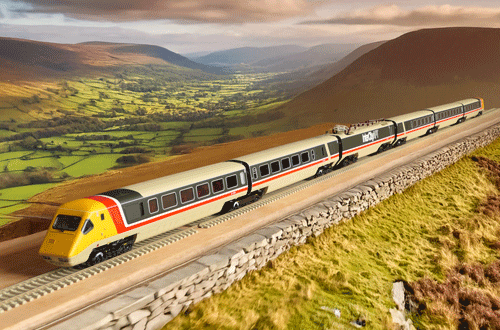
370001 was a testbed throughout its working life, was never more than three vehicles long, and never carried passengers. It was initially formed of three cars, built as DTS 48101, TS 48206 and TBF 48601. However all three vehicles were equipped with test equipment before turning a wheel in anger - instrument racks, mess and workshop facilities, and even an auxiliary diesel generator in the brake van to power all of the above. BR's intention had been to complete testing and have all trailer rakes trains extended to full length and in public service by the end of 1980, which would have seen 001's test gear removed, standard seating fitted, and the set extended to its full 6-car length. In the event, in 1981 the set was given its black cab window mask but instead shortened to just two cars with the removal of test car 48206. It remained the primary test unit and sported a variety of internal layouts over the next few years. In 1984 the non-articulated APT-U Development Coach was coupled between the set and the adjacent power car.
The starting point for this model was Hornby set R3873, the five-car, yellow-fronted 2020 release (370003 + 49003 + 370004). In addition I required a TS car and two of the 48204 APT Development Coach models - you'll see why below!
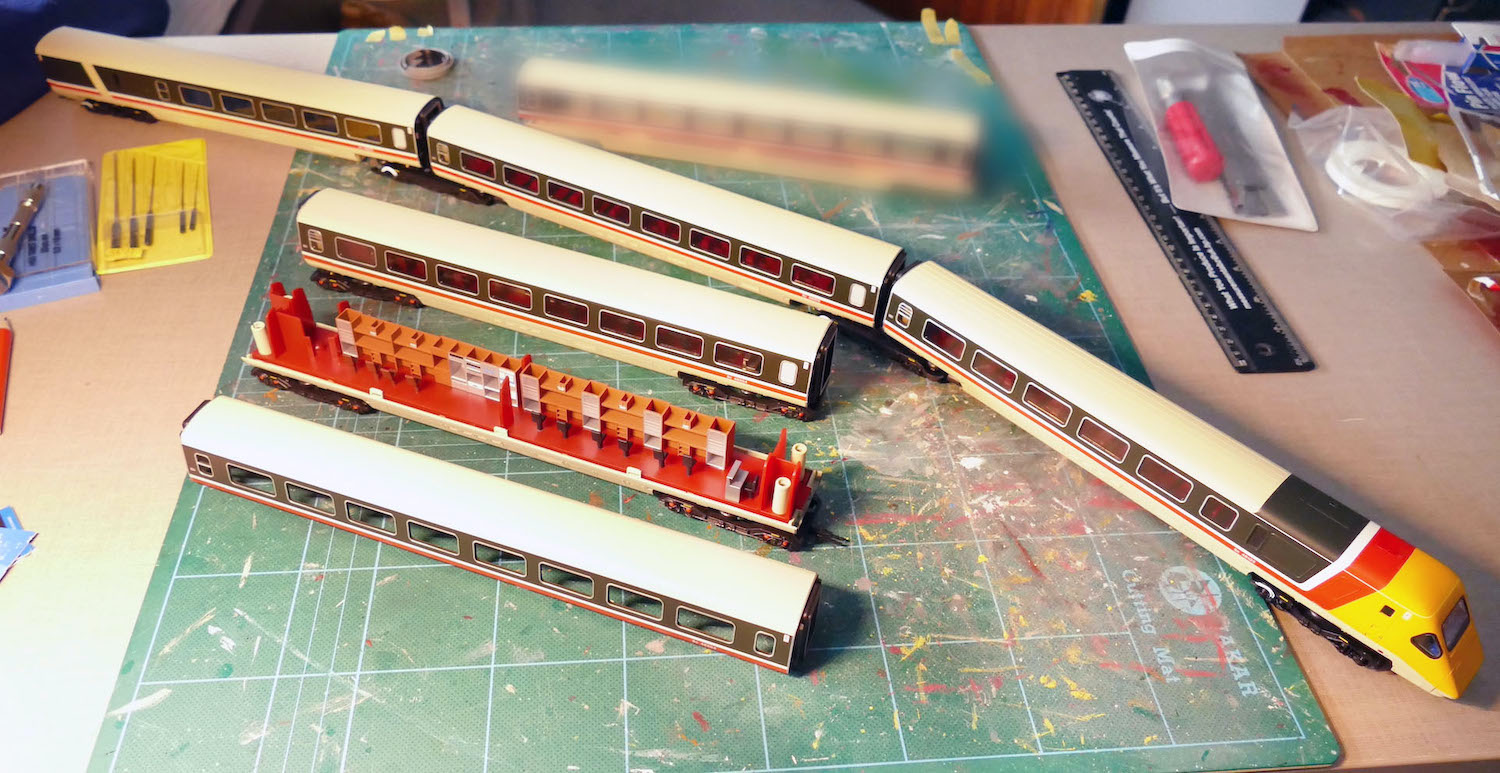
The first stage of the project was to create test car 48206, with its internal equipment racking and so on. The vehicle was originally constructed with its full complement of seats, but these were removed sometime in late 1978 or early 1979 for its role as a test car. Externally 48206 was unchanged - internally, however, it featured equipment racks at the inner end nearest the TBF car, with some seating and a workshop area at the outer end.
Here we must immediately digress and move forward several years to 1984 when a different test car was created from TS 48204. This vehicle had previously operated in 370003 as a regular TS but was modified to be non-articulated, and ran between 370001's TBF and the adjacent power car. It too was fitted out with equipment racks at one end, with regular seating retained at the other. Hornby produces this "Development Coach" as part of its 7-car sets, and also as a separate vehicle.
BUT what's very useful about the model is that while it contains a pretty good likeness of the 1984 equipment racks at one end, it also contains a pretty good likeness of 48206's 1980 equipment racks at the other! I expect this helpful error occurred when Hornby's researchers found images of both vehicles' interiors, which are admittedly very similar, didn't realise that two separate vehicles had existed at different times, and concluded that they were different ends of the same coach.
As a consequence, the construction of 48206 also allows the creation of a more accurate model of the 1984 non-articulated test car, 48204.

So the first step is to dismantle everything, and, since APT vehicles are always the same way around in a half-rake, make a point of labelling the relevant ends of the test cars - in both cases the end adjacent to the TBF car was where the equipment racks were housed, which in reality minimised the amount of cabling needed from the generator set in the brake van area. Worth noting that because the two cars were marshalled at opposite ends of 001's TBF at different times, their interiors are the opposite way around to each other.
The interior mouldings of the Development Coach and the TS vehicle were cut in half and swapped around to form the basis of the new interiors for both vehicles. Some additional adjustments of the mouldings were required to get the various sections to fit into their new locations, owing to the differences between the regular and modified vehicles' bogie pivots etc.
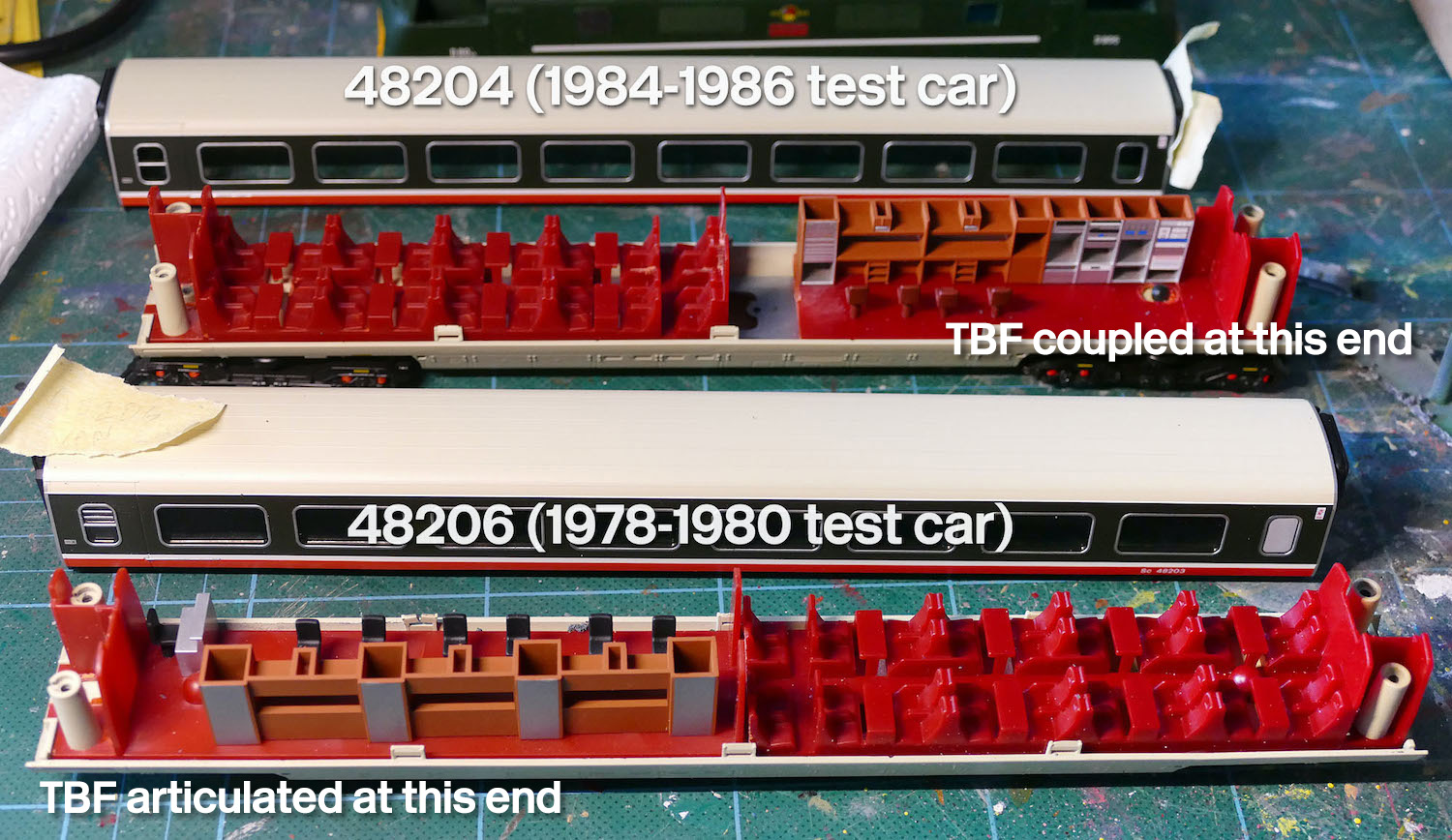
Photos of 1984 test car 48204 suggest that the full complement of seating was retained in the other half when converted, however it's a different story for the 1980 test car, 48206, with only a handful of seats retained at the other end of the vehicle. To recreate this, the surplus seating was cut away, and a new plasticard floor added.
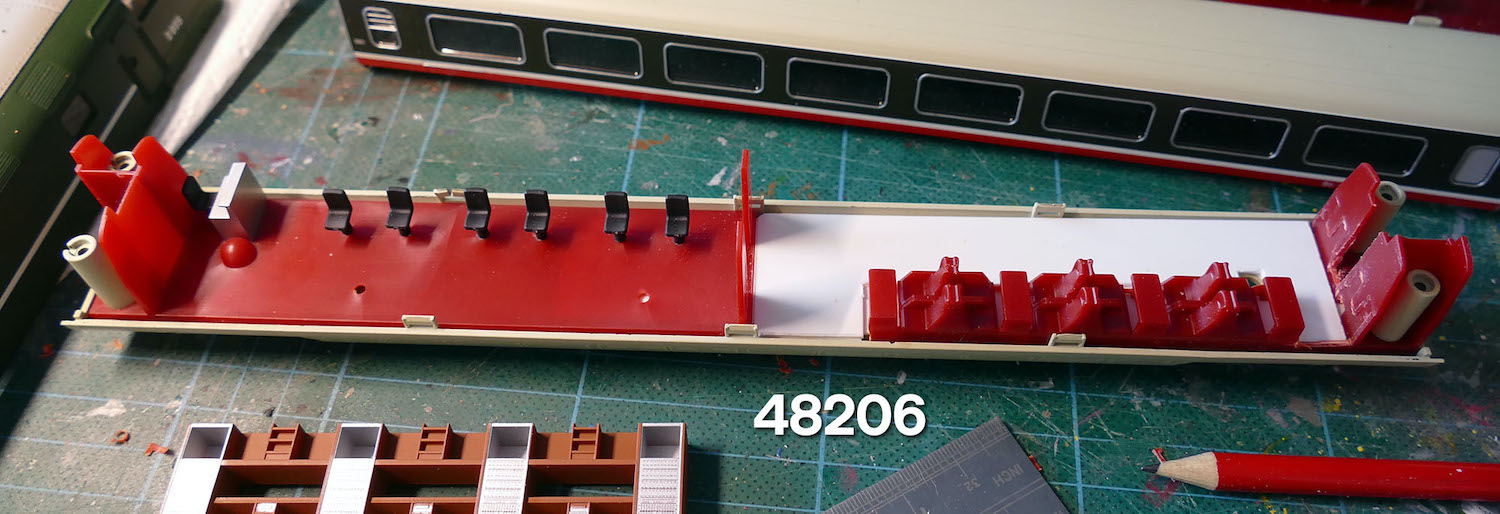
One minor detail that no-one else will ever see: 48206 did not have standard APT tables - it had wooden ones with angled corners - so a quick snip or two with the side cutters did the trick.
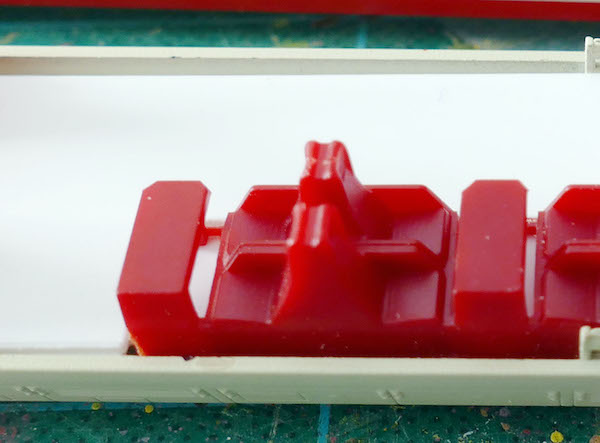
Forward again to 48204 - a few seconds of footage from a documentary reveals the layout at the right-hand side of the equipment banks (in 1986) where an angled wall leads from the end of the racks to the end wall, with a narrow doorway in it for access through to the TBF car. This was recreated in plasticard along with another angled wall at the other end, with a doorway arch leading through to the saloon.
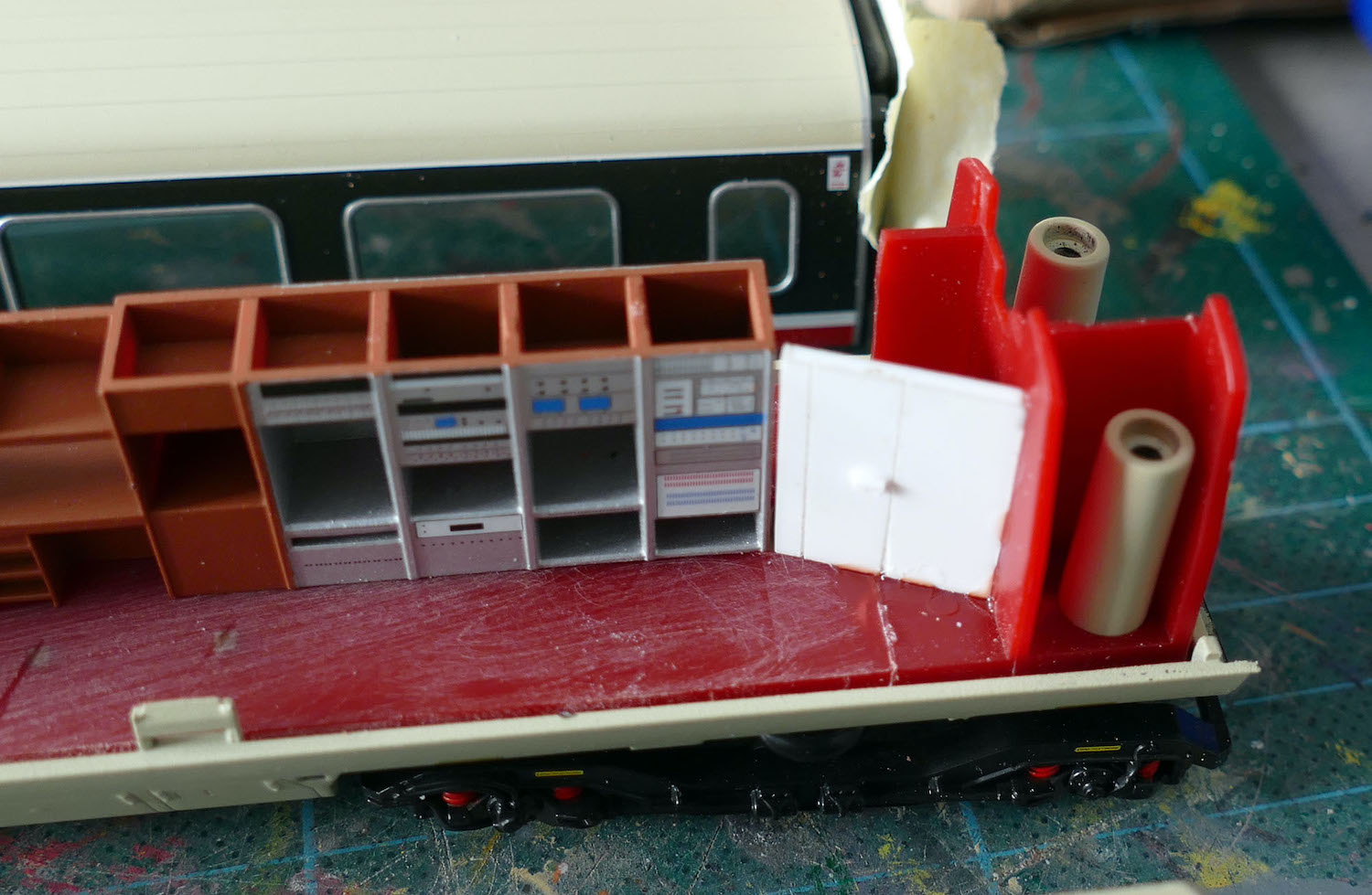
Across from the seats in 48206 was a long workbench. In reality it appears to have been made from several kitchen units and a long worktop, but plasticard sufficed for this recreation.
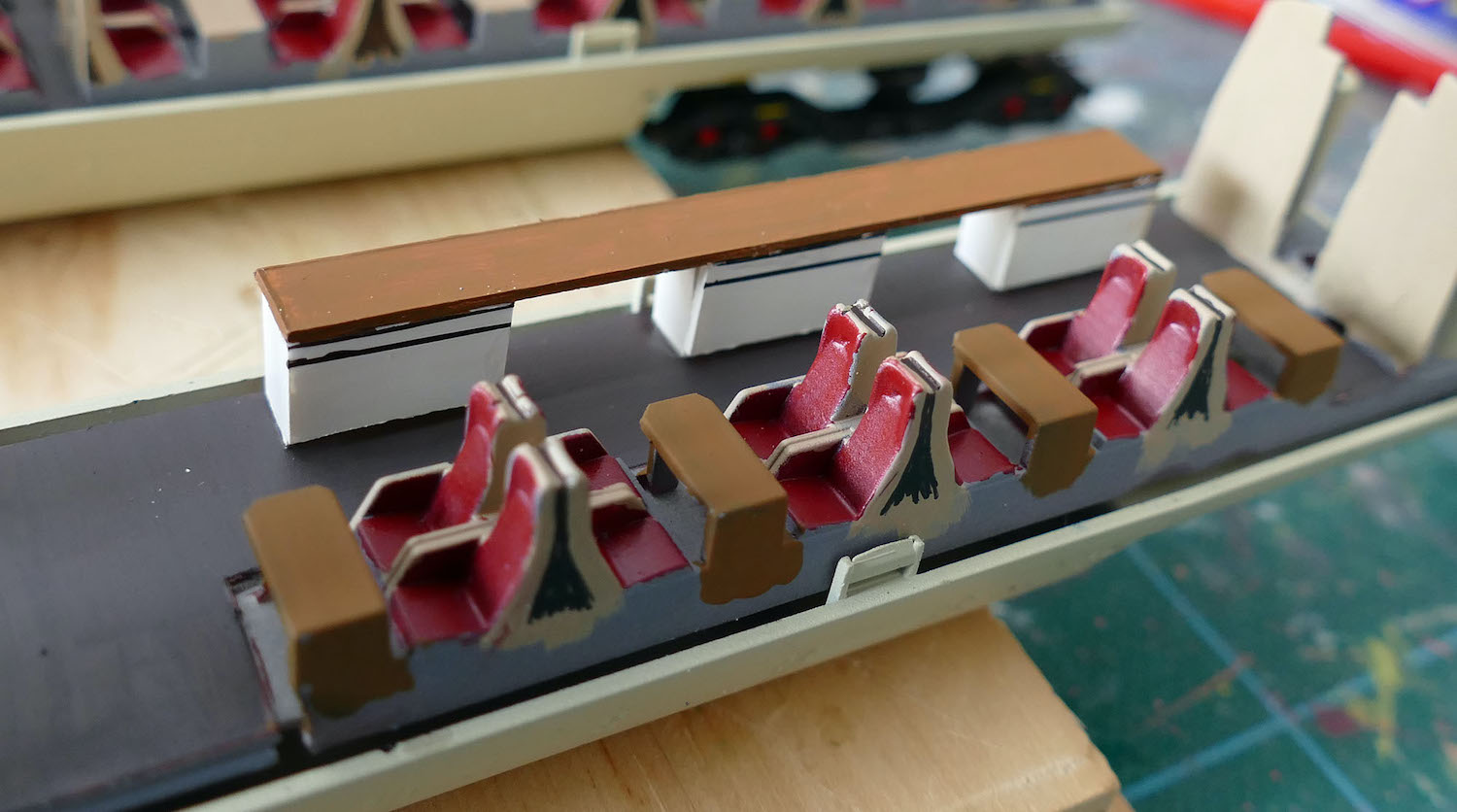
The silver of the equipment racks in both cars was painted out with blue and various small items, crudely representing test equipment, were added to the empty shelves and upper rack spaces. I don't have a 3D printer, so for now some impressionist blobs will do.

Comparisons of the two interiors:
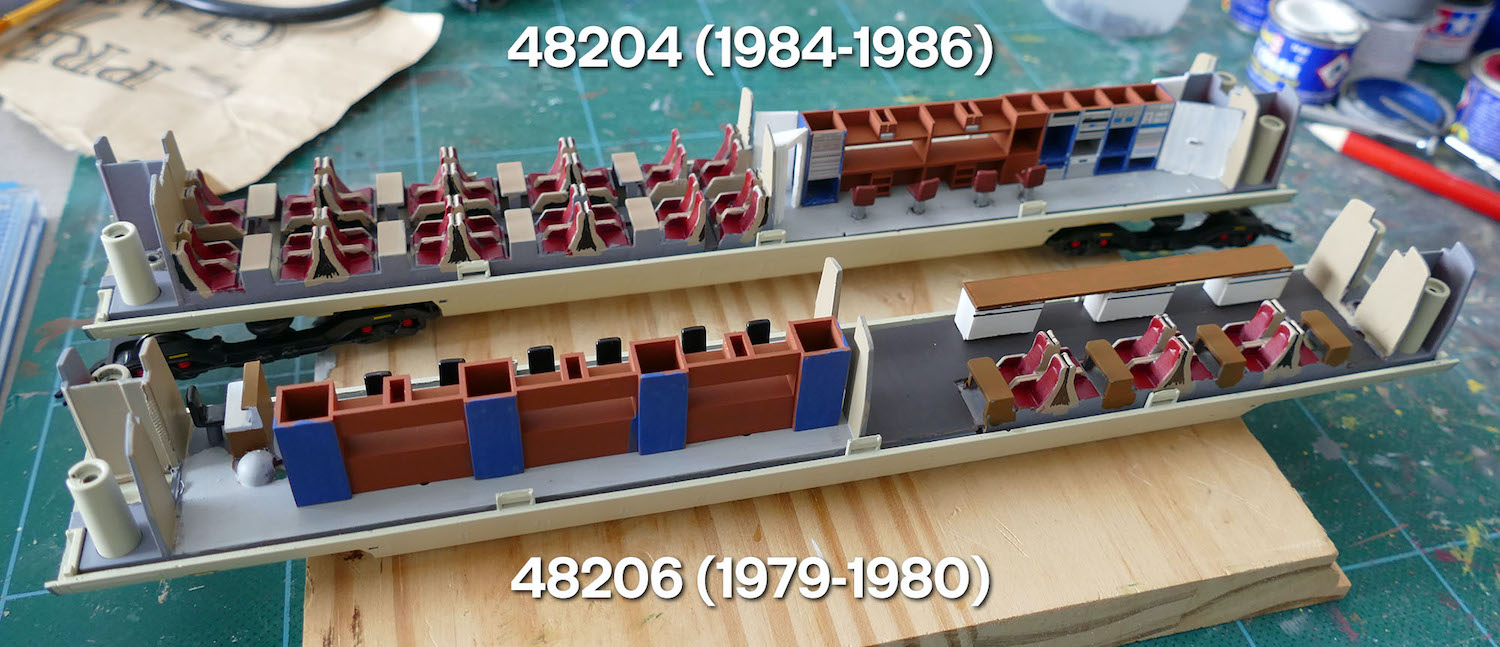
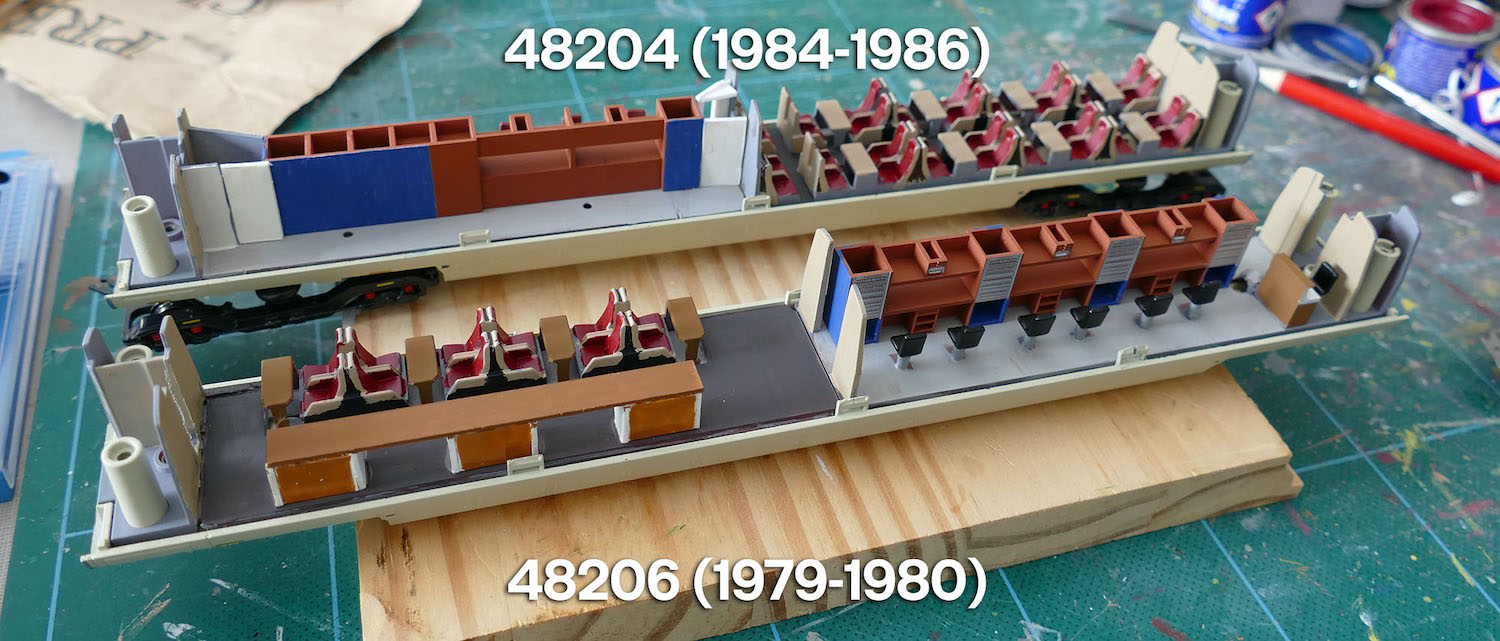
370 001 - TBF and DTS
The interiors are not quite as involved as 48206 - the driving trailer and trailer brake vehicles have less in the way of equipment racks (but for these the second Development Coach was needed), and more in the way of a whole lot of empty space. The TBF (blue mouldings) was gutted, leaving no seats in place, and on the real train the floor was laid with functional vinyl tiles. Plain plasticard replaces the seating area on the model. The DTS is a little more complicated, as a handful of seats were retained to the rear of the mid-saloon bulkhead. The forward saloon area was cleared and re-floored for test equipment, while the remainder of the rear saloon retained carpets but lost the seating.
One curious feature of the retained seating in the DTS were the original APT tables with raised edges, which I believe were designed to hold meal trays, but which made them somewhat impractical for anything else. These didn't seem to make it into the in-service units, so for the mad fun of it, I cut some slivers of plasticard to represent this design. There are only four tables in the DTS, so why not?
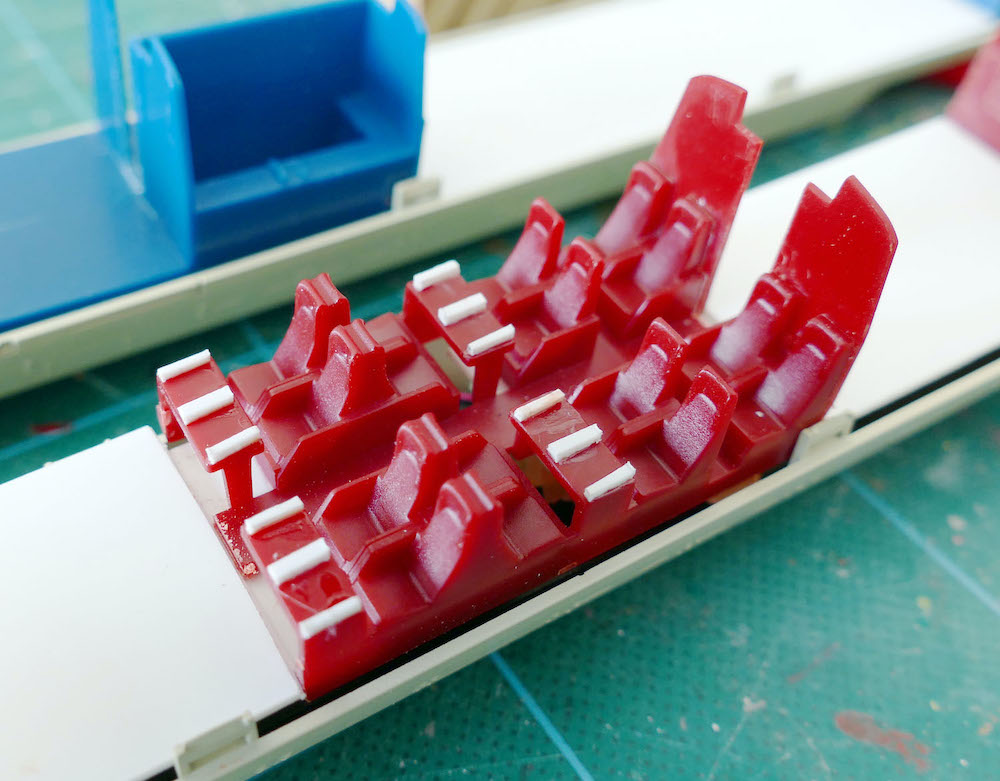
The equipment rack in the TBF (which was apparently for pantograph monitoring) was formed of two racks and a desk a little bit longer than those in the test car. The configuration of the desk is different to the sections available in the Development Coach interior, however rather than try to carve the exact arrangement of verticals, I hacked together two sections of "regular" desk to give a reasonable overall impression.
An interior layout diagram of the DTS shows a further desk-and-rack set-up (for C-APT testing - the cab signalling system used by the APT), but to date I've found no photos that show this set up in place. On the assumption that the rack was installed at some point, a further set of racks from the extra Development Coach were used to represent this.
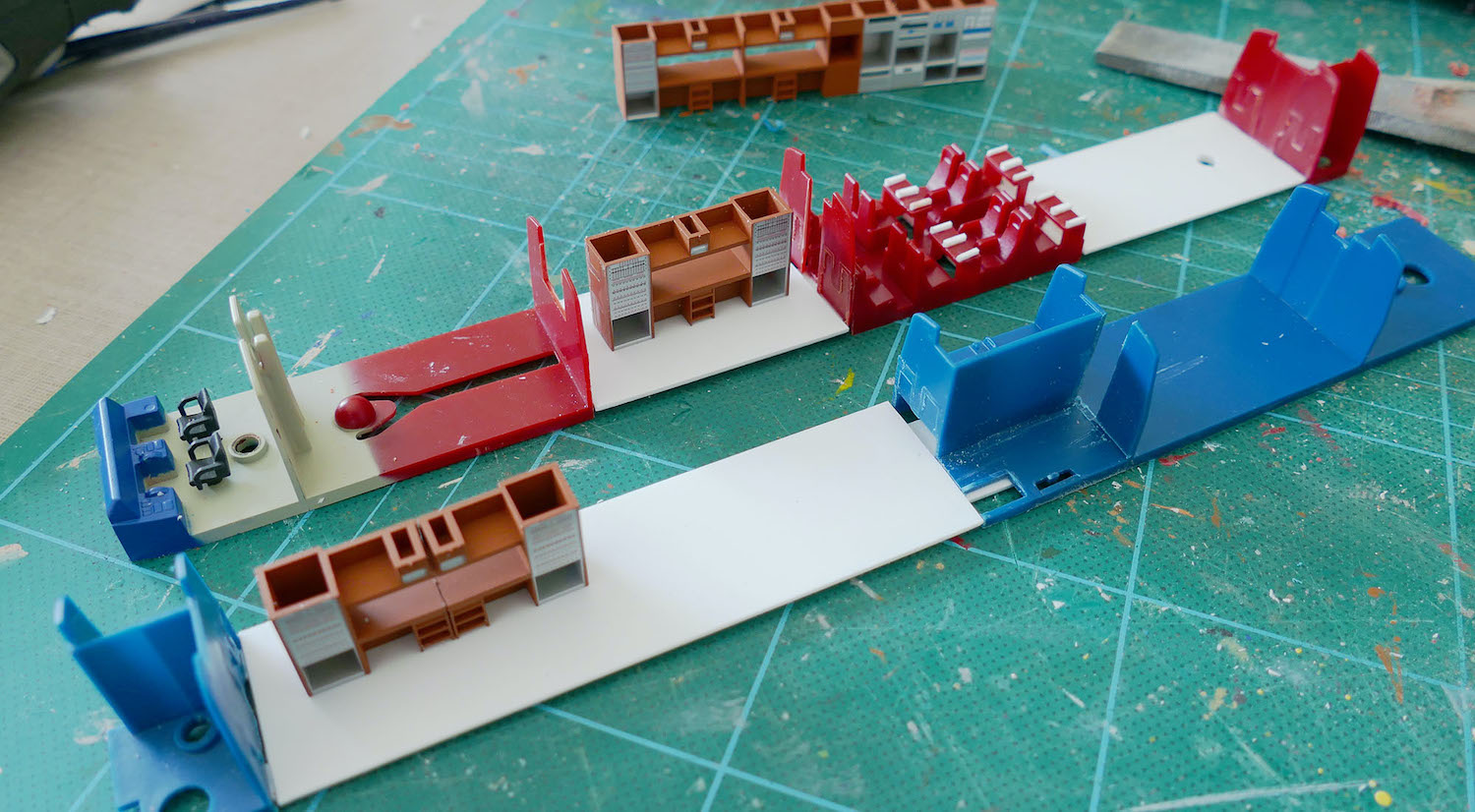
In addition to the C-APT electronics racks, the DTS retained a handful of seats as a mess area for on-train personnel. In one corner was a literal kitchen sink! This was fabricated for the model from the side window of an unpainted Hornby Class 37 body and inserted into the counter-top of a plasticard worktop and cupboards. Similar workshop units complemented this in the TBF, created based on the interior layout diagrams and a glimpse in the corner of one photo!
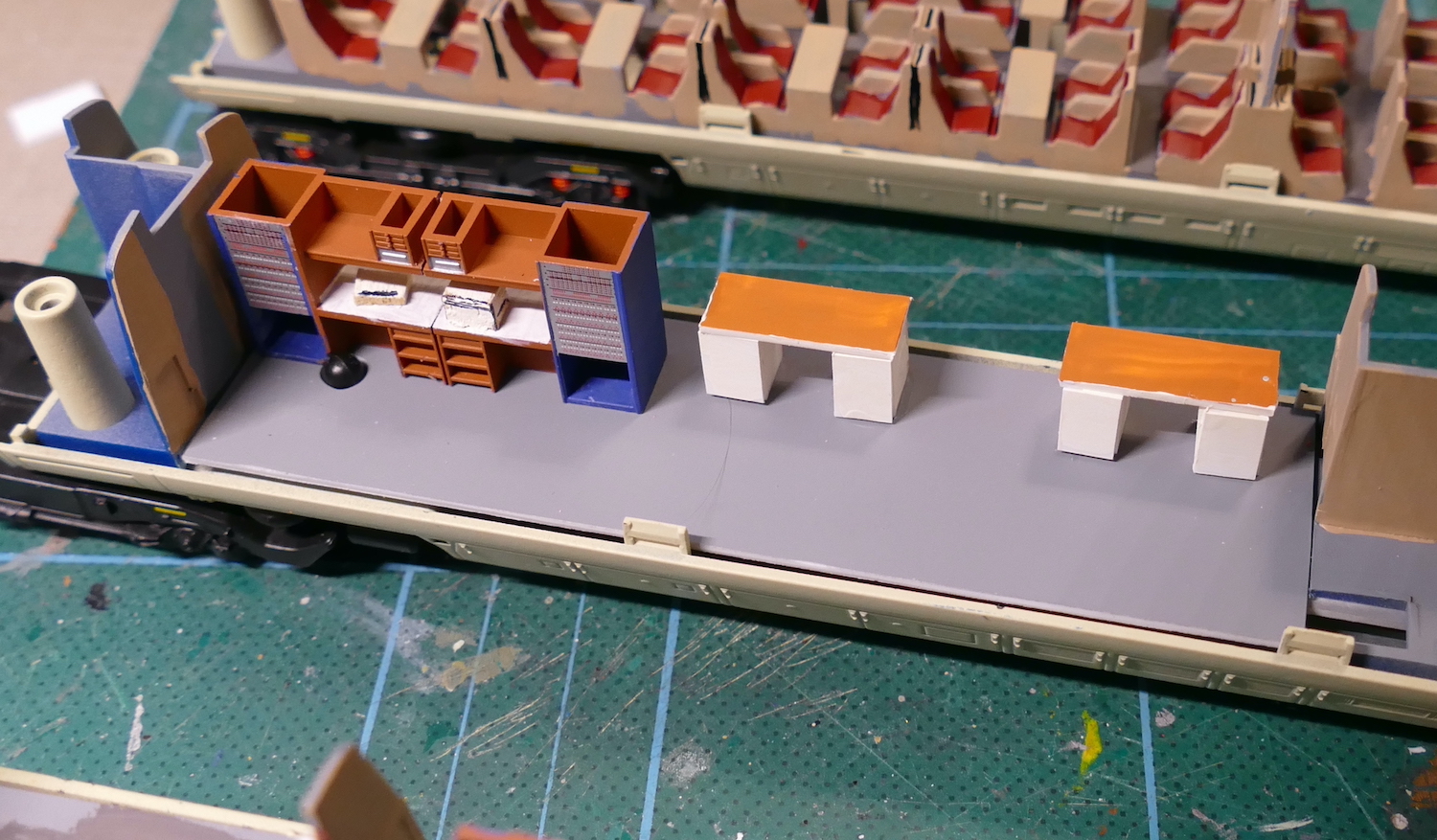
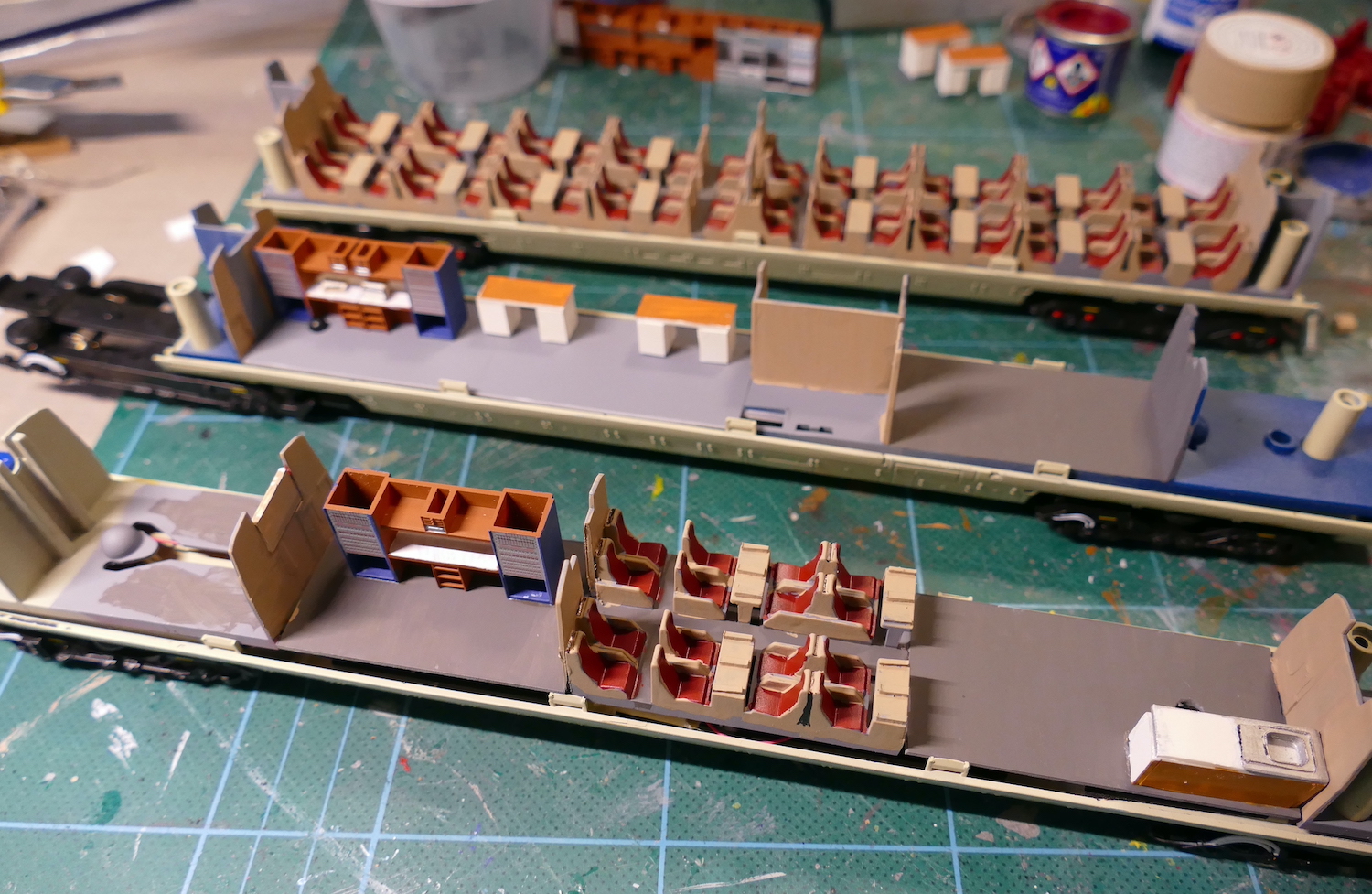
To power all the test equipment on board 370001, a diesel alternator set was installed in the van compartment of TBF 48601. To provide an air supply to cool the engine, the two destination windows fitted to the van were removed (including the frames) and vents added behind them. For the model, the exterior window frames were then removed, and a slight chamfer added to represent the resulting inset. Some crude bits of plasticard were fashioned to create the insides of the vents as seen "through the hole" from the outside. Additionally panels were mocked up to look like the shape of the generator itself, such that it might just be glimpsed through the windows.
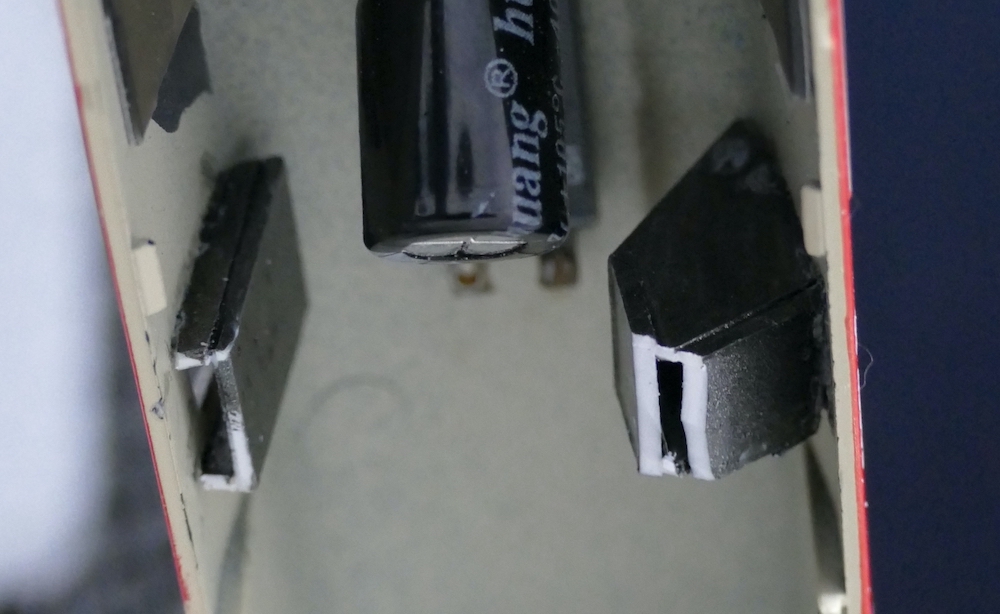

The diesel set, of course, had an exhaust, and this can be seen sticking through the roof of 48601 in many photos. After studying as many of these as I could find, the "correct" position for the engine's exhaust port was marked out on the roof, and then very slowly and carefully drilled out by hand. Once through, a length of ballpoint-pen ink-tube was chopped off, which was exactly the right size for the hole, then carefully shaped at the exposed end into a weird shallow "v" which can just be discerned in many photos of the real thing.
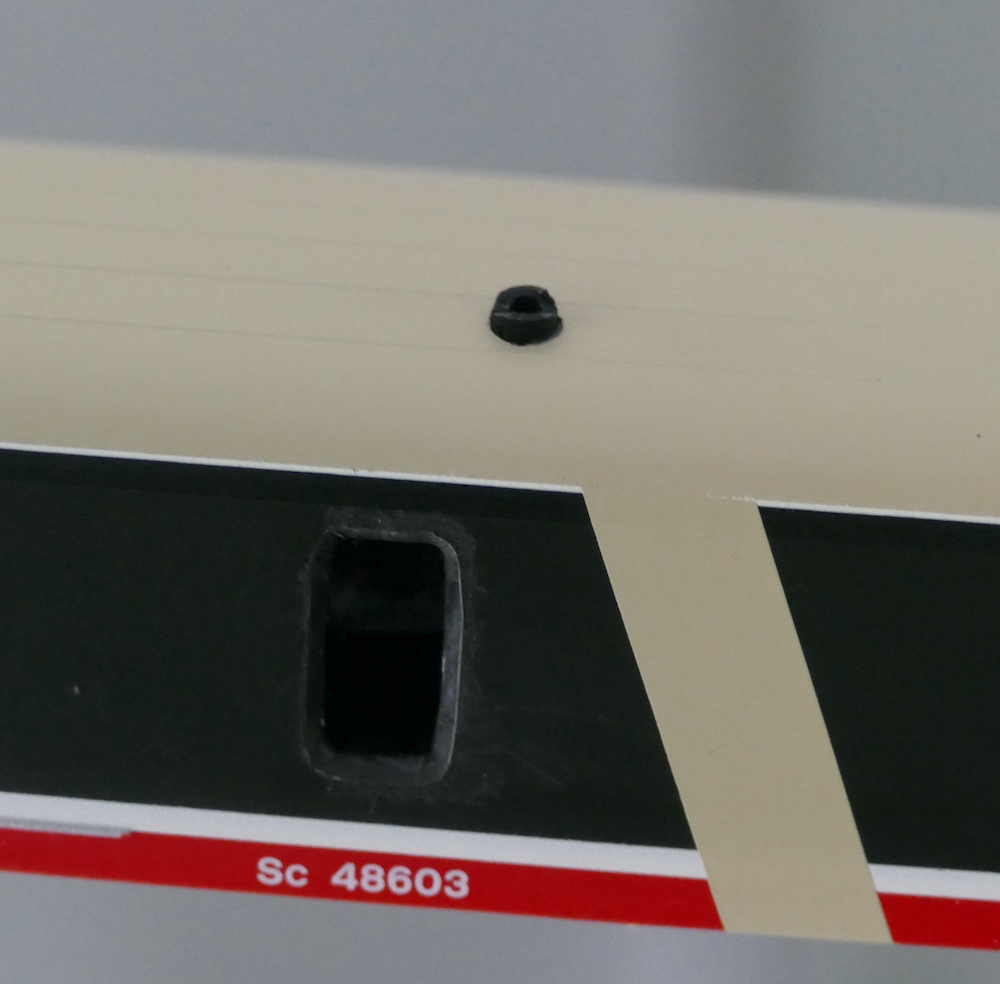
48101: Nose Surgery
Several details on Hornby's model don't match with the condition of the APTs as built.
First of all, the raised surround to the horn grille was carved off and sanded flatter. On the real trains, these mouldings sat flush with the nose cone, and only over time became slightly raised as the two pieces flexed with use. Much later some were replaced by rivetted-on grilles, or plated over.
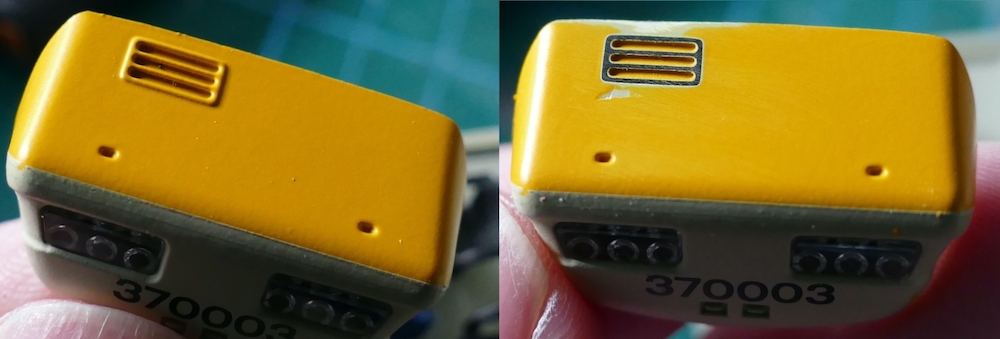
Secondly, the rain strip under the windscreen was a feature that wasn't added until around 1981 in most cases - none of the units had them fitted while wearing full yellow ends. So that was also carved off.
One curious detail on the Hornby cab front is the recess into which the windscreen frame is set - no such recess exists on the real train, and it's particularly noticeable on the model at the top corners of the windscreen. This was treated with a bit of filler to smooth out the feature a little.
Paintwork
At this stage of its career, 370001 had its destination blinds wound to blank, so the insides of the DTS windows were painted dark grey.
The black window frames on the Hornby model are a little too bold, these were repainted a little thinner.
One thing that most will probably not too concerned about is the colour of the red stripe on Hornby's model. It's actually a little too red for the correct shade, "Rail Red", which is quite an orangey red. You can, of course, choose to ignore this, or you can do what I did and carefully mask / repaint all the red on all the bodies.

On the left, Rail Red. On the right, Not Rail Red.
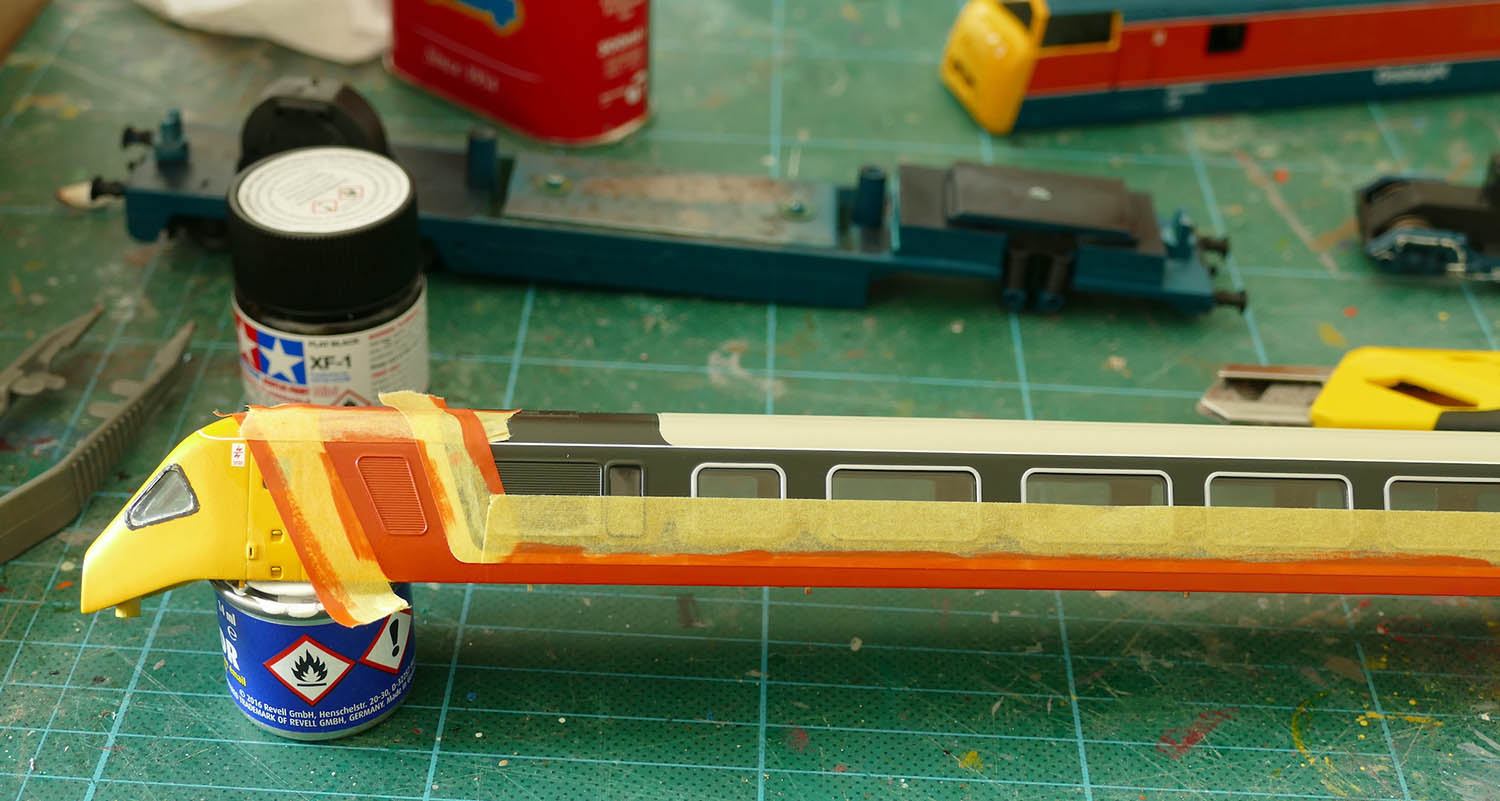
All three vehicles of 370001 showing the modified interiors, with 370004 waiting patiently behind, plus the corrected Development Coach for a few years down the line.
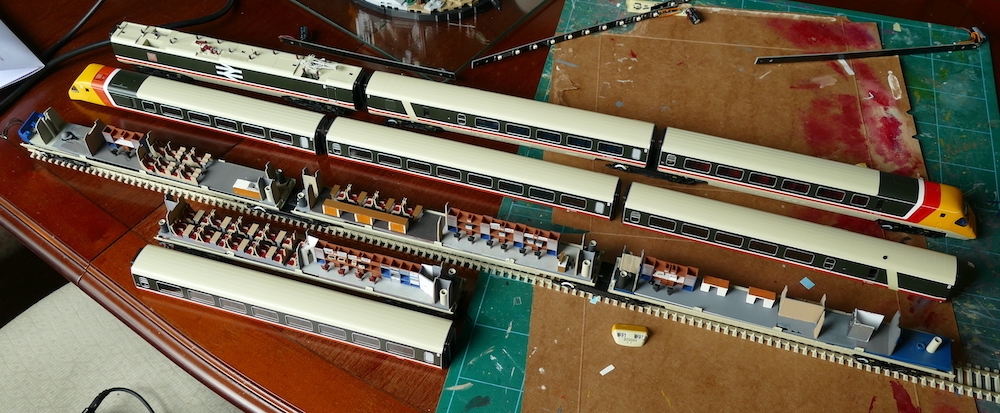
370 004 - The Lost Unit
370004 had an odd history - being probably the most photographed APT, and apparently the first to be taken out of use. When it first emerged from Derby it was a four car trailer rake, comprising the DTS and TBF you'd expect, 48104 and 48604, plus two other trailers, one of which was a buffet car. I have speculated that these are TRSB 48402 and TF 48502 based on vehicle allocations recorded in publications from the time, but so far I don't have photographic evidence that confirms this. Nevertheless, aside from commissioning runs with prototype HST power cars, as far as I can tell, 370004 never ran in this condition with another trailer rake.
When it was paired with four-car 370003 in 1979, it had been reduced to the minimum formation of DTS and TBF, and the two intermediate trailers were never seen again...
With 003, it could be found primarily on the southern WCML from the end of 1979 through to mid-1980, principally operating driver training and familiarisation runs. Initially the pair ran with power car 49003 - Hornby's 2020 release with 003 and 004 is pretty accurate - you only need a couple of trailer cars for 003 to create that rake. However by early 1980 the power car had been swapped with 49001. The pair continued to operate until June 1980, and made a somewhat work-stained appearance in May at the Rainhill 150 celebrations, with 004 leading and 56077 shoving at the back. And thus 004 became the most photographed trailer set!
At the end of June or early July 1980 370004 and 49001 were commandeered to participate in trials of one of the first Brecknell-Willis high speed pantographs. For this, the set was paired with three car test set 370001, while their erstwhile partners disappeared back to Derby for rebuilding and (theoretically) extending to full-length rakes.
As far as I can tell, 004's interior was not modified in any significant way, which means that interior detailing was limited to painting the seats into less garish colours. For the exterior, the same front-end modifications as 001 were carried out - removal of the rain strip, filing down of the horn grille frame, filling in the recesses in the windscreen corners, and reducing the size of the black window surrounds.
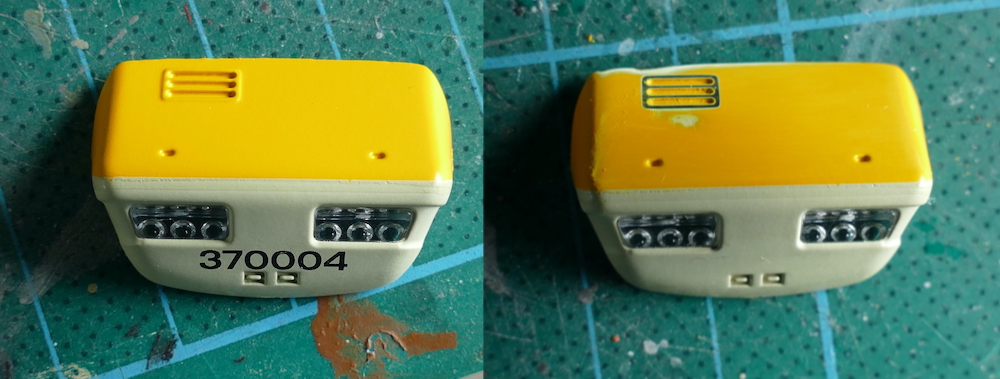
Painting
370004 had a couple of unique features up on the roof. Firstly, the lift-out panel above the auxiliary diesel set in the DTS appears to be unpainted. It's unclear from photos whether it had any major detail differences to the standard panel, so I've assumed it was the same. To that end, the area of the panel was masked off and given a vaguely dirty-metal finish.
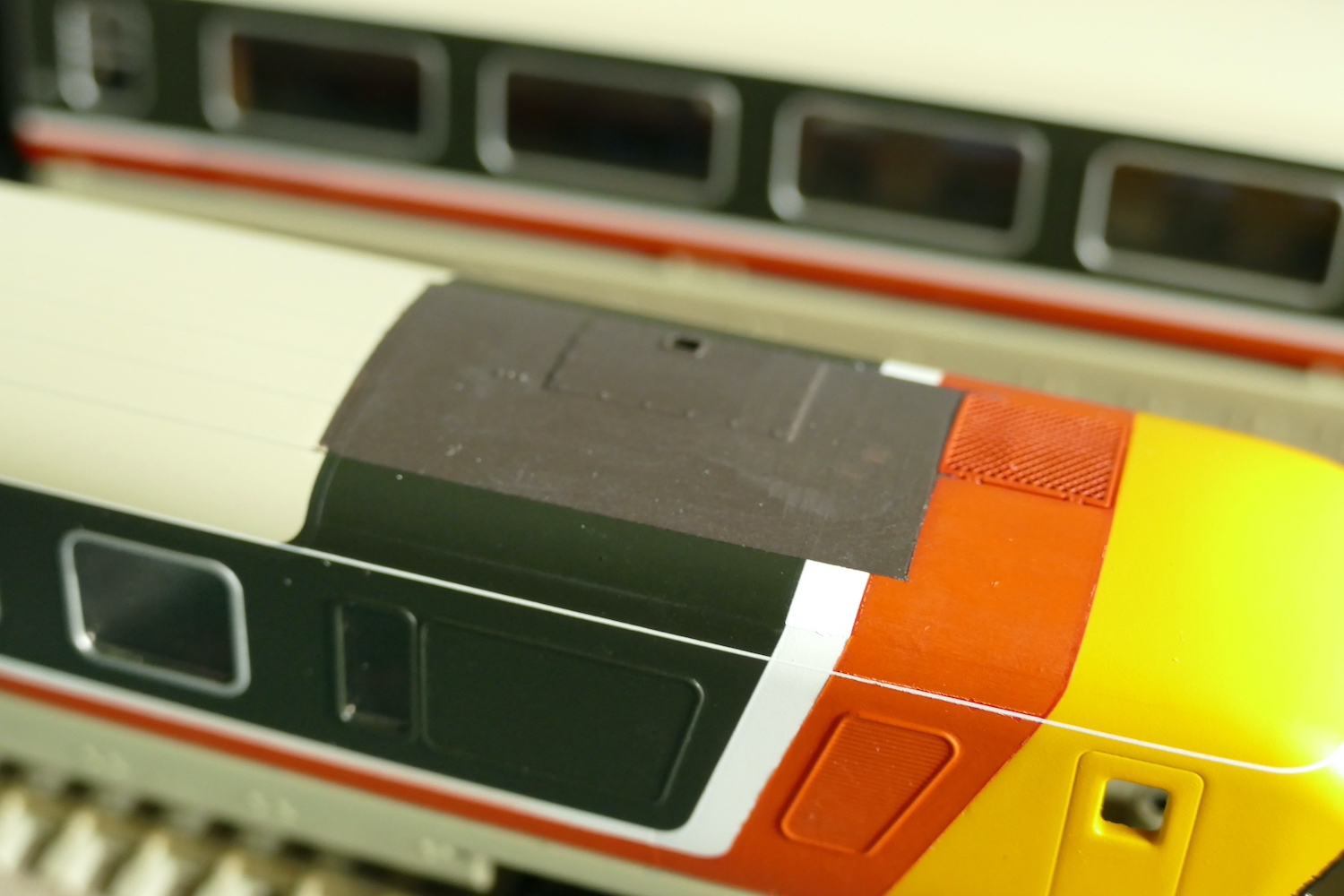
The TBF had a similarly darkened area to the rear, over the van. This required a little more surgery, as the moulded longitudinal ribs extended into the area of the panel. These were carefully carved off before the area was masked and painted a similar dirty-grey colour. Photos are again not very clear as to the detail of this area, so the remainder of the moulding has been left as-is.

Pantograph Testing - Power Car 49001
Power car 49001 initially operated in 1979 between 370001 and 370002, along with 49002, but by early 1980 it could be found between 370003 and 370004. When tests were requested for the then-new Brecknell-Willis High Speed pantograph in mid-1980, the first two operational APT pairs were split and reformed. 370001, with its test equipment, was commandeered along with 370004 and power car 49001, which was fitted with a prototype of the new pantograph plus cameras and other roof mounted monitoring equipment. I have read that the APT team were somewhat reluctant to participate in the trials as they had their own issues to deal with at the time!
The starting point for the model was power car 49003, supplied with the Hornby 5-car set. Numbers and printed nameplate were removed, and a rail red stripe added. As supplied, the model comes with an original two-stage Stone-Faiveley pantograph, so this was removed. A spare Hornby Brecknell-Willis pantograph was obtained painted dark blue to match the prototype. Of note for rivet counters like myself, 49001 appears to have been the only power car to run with a Brecknell-Willis pantograph while retaining its white cantrail stripe.

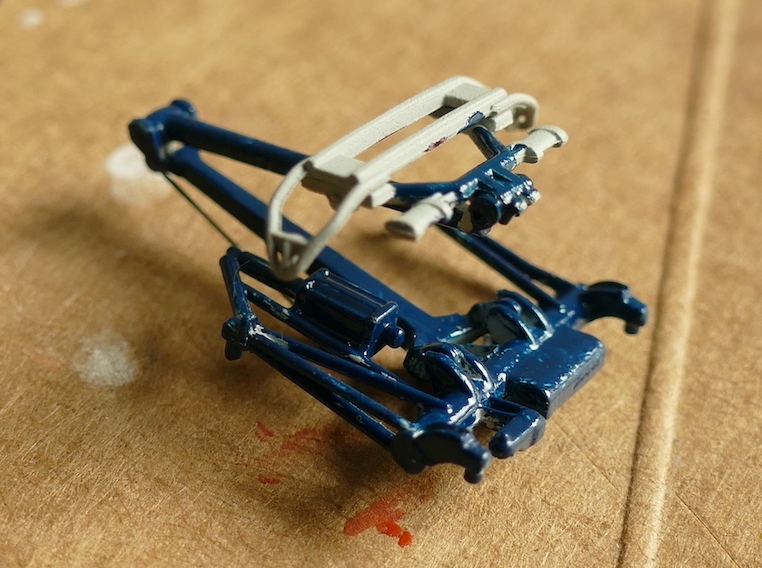
As I was scouring photos of 49001's roof area, trying to identify the exact locations for mounting the cameras and other features, I spotted something I'd not noticed before. As can be seen on the Hornby model, there's a kink in the bus-bar, with one insulator mounted on an additional plate, next to a tall bar. This appears to be the pantograph isolating switch, presumably to allow the pantograph on the power car to be completely isolated from the power supply coming from the adjacent power car. However - it appears that the addition of this switch was an early modification to the fleet. In mid 1980, 49001 had not yet been so fitted, and thus the bus-bar ran directly between the "regular" insulators either side of where the switching insulator was installed. Some carving and sanding of the roof, plus replacement of the kinked section of bus-bar mimics this on the model.
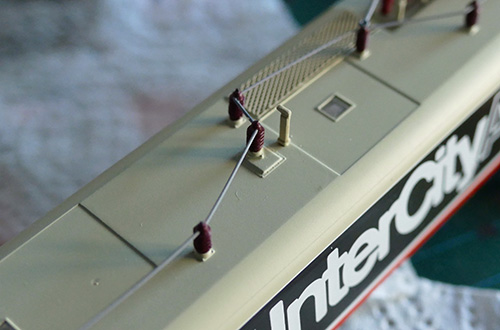

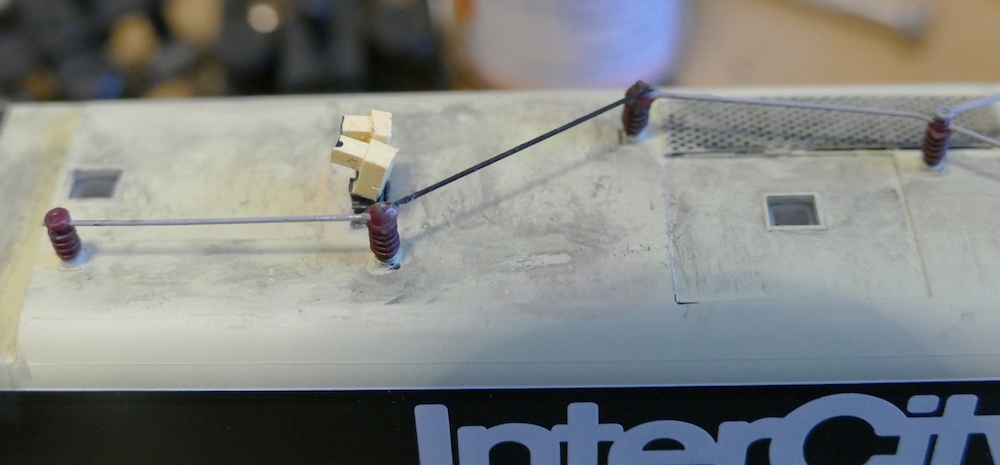
Lights! Cameras! Action!
49001 was fitted with what I'm calling four "cameras", front and back of the pantograph. These were mounted on twin brackets and appeared to be in some sort of cradle, and able to be angled. There isn't a huge amount of detail available from photos, but in 4mm scale, there's not a huge amount of detail possible, so I interpreted as best I could. In addition, at the outer end of the roof, flanking the "knuckle" end cameras, were two electrical boxes. These were mounted on the roof via side brackets, but the boxes themselves were at a slight angle.
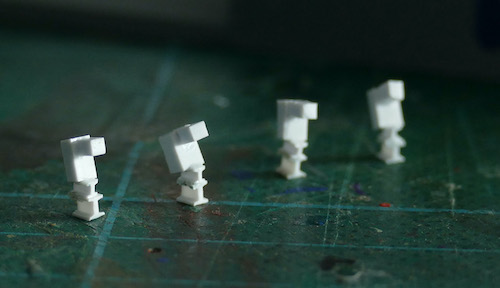
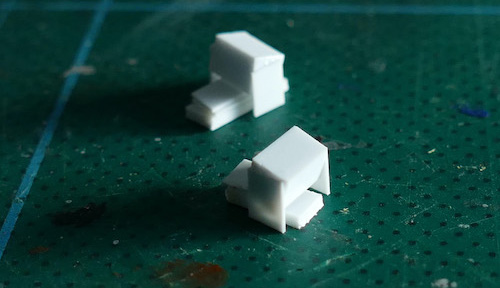
The result shows the pantograph end with cameras and boxes fitted, and isolation switch removed. The tilt mechanism channels at both ends were also blackened as per the prototype.
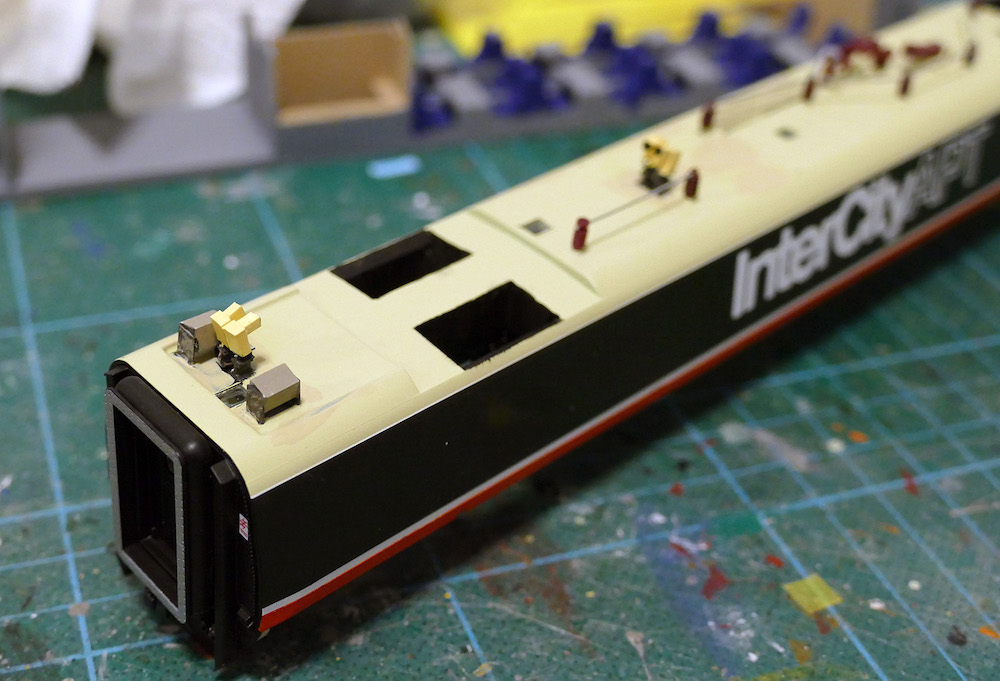
With the external modifications complete, the units were reassembled and weathered. Numerous photos of the real formation were studied for the weathering, and I went for a slightly-exaggerated version of the worst bits of all of them, to give the workhorse-like appearance that this set had during this period. This included a number of "paint scratches" that could be seen on the prototype.
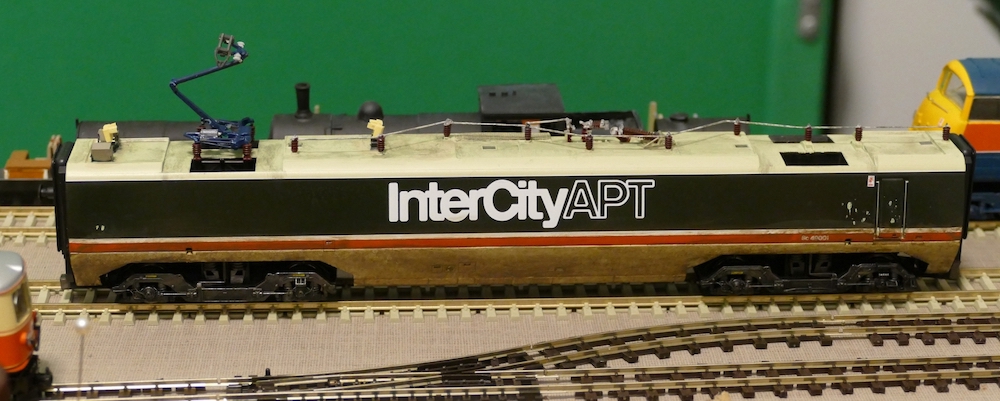
For an electric train, the APT had a surprising number of diesel engines on board - all APT-P driving vehicles had auxiliary generators behind the cabs, the exhausts from which would leave stains down the yellow ends and along the roof. 48104 in the foreground was often fairly grubby up top. 48101 behind tended to have a little less dirt on the yellow, however 001's TBF vehicle also had a generator to power the test equipment in the set - 48601's roof (at the back) was nearly always smudged with smuts.

The end result
Since beginning the APT formations page project, and really delving into which units did what and when, I had an urge to model 370001 "correctly", with all its internal modifications and unique features. While doing a model of 001 and 002 together in their original form was considered, it was the dirt-covered pairing with 004 that really inspired, with all the roof-mounted clutter on the power car. Added bonus - I saw this set failed at Preston back in November 1980!
After the pantograph trials, both sets returned (probably in early 1981) to Derby, but by this time, BR's APT plans were going somewhat awry. The plans to rebuild and extend the sets to full length never came to be. Instead, 001 lost 48206 and was shortened to two cars, now with a black mask. The DTS and TBF vehicles were not rebuilt to carry passengers, though some additional seats were added to the DTS for later testing roles. Eventually the set was paired with the "new" non-articulated 1984 test car, 48204, only this time the car was marshalled between the TBF and adjacent power car for obvious reasons. The set was scrapped at Derby in 1987. 004 suffered a less glamorous fate - while it was repainted with a black mask, it apparently never returned to use, and instead the two vehicles spent several years marshalled either end of a full-length trailer rake at the Derby APT centre, gradually being cannibalised for parts before being cut up in 1986.
So in this model I've attempted to recreate the "glory days" of the two sets, when going flat out to test the limits of power collection was all the rage.



